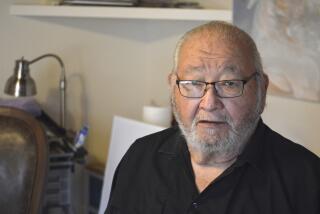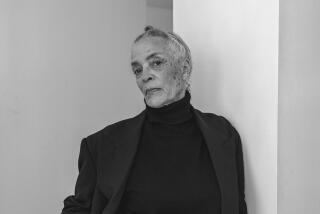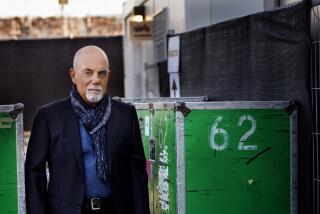Hemingway at 100: The Old Man and the Sentimental Journey
- Share via
KETCHUM, Idaho — Ernest Hemingway, born 100 years ago this summer, is buried in a small cemetery near a two-lane highway, facing the foothills at the base of Bald Mountain. His tombstone is granite and rectangular, inscribed in simple, declarative language:
ERNEST MILLER HEMINGWAY
JULY 21, 1899 JULY 2, 1961
There is no mention of his widow or three sons. No literary epitaph is offered. Odder still, the letters are not chiseled in the center of the tablet, but below, as if the large, blank upper section were left open for comments.
To judge by what’s been said about him, here are some possibilities: hero, bully, gentleman, sexist, hunter, killer, truth-teller, fraud, explorer, drunk.
Hemingway died before the March on Washington, the Vietnam War, the women’s movement, AIDS, self-help, animal rights and 12-step programs. He died before his open celebration of white male power became a symbol of tyranny instead of freedom. He died before the emerging writer’s formative experiences shifted from wars and cafes to workshops and graduate programs.
He was not simply an artist but a way of life. For those paternalistic times, he was “Papa”--man of experience, sage, benefactor, looking fondly on his young admirers, including female ones he liked to call “Daughter.” He stood for fighting, drinking, womanizing, tough-guy fatalism and--strange for a man whose tales grew ever taller--old-fashioned honor.
Parodies Began in the 1920s
But even in his lifetime, the blank slate of reputation was endlessly filled, erased and filled again. Parodies of his writing appeared as early as the 1920s, when his career was taking off, and critics soon complained that Hemingway was becoming a parody of himself. The same things he was worshiped for--his spare language, his robust adventures--were the things used against him.
No writer has borne quite the burden of Ernest Hemingway. He is a symbol for everything grand and everything awful about literature. For a good part of this century, he has been not just an American writer, but the American writer, one young authors aspired to emulate or to avoid, whom critics wanted to canonize or attack.
“He embodies the dangers of becoming an icon and having to reproduce that for public consumption,” said John Edgar Wideman, whose novels include “Philadelphia Fire” and “Sent for You Yesterday.”
“Well, he asked for it, didn’t he?” said Frank Conroy, author of the memoir “Stop-Time” and director of the University of Iowa Writers’ Workshop. “Hemingway was absolutely outrageous, the way he lived. He tried to be this big, burly guy who wasn’t afraid of anything, and it turns out he had feet of clay.”
*
The sign leading to the house where Hemingway died, a short drive from downtown Ketchum, does not welcome tourists or even mention his name. Like a cold-eyed guard dog, it appears just to glare at visitors and growl: “Private Property. No Trespassing. Violators will be prosecuted.”
Hemingway’s concrete lodge, built into the foothills and stained brown to look like wood, can be entered only by special appointment. When Mary Hemingway, his fourth and final wife, died in 1986, she donated the 14-acre property to the Nature Conservancy, an international nonprofit organization.
“She wanted the land preserved as much in its natural state as possible,” said Guy Bonnivier, the conservancy’s Idaho director. “The intention was that it wouldn’t be overrun with people.”
Hemingway’s books are still popular around the world, and his centennial has been a chance for additional cashing in. A new work of fiction, the unfinished “True at First Light,” has been published. Readers can wear a Hemingway T-shirt, drink Hemingway coffee out of a Hemingway mug, sit on Hemingway furniture and use a Hemingway pen to write on a Hemingway pad.
Ketchum Holds Higher Standards
But Ketchum keeps a respectful distance. If you want to buy something with Hemingway’s name on it, the fine local bookstores carry all of his titles. Instead of guided tours, there are scholarly lectures on his life and work, and modest exhibits at the local museum and public library.
“You won’t see Hemingway look-alike contests here,” said Marsha Bellavance-Johnson, a local historian and author of the booklet “Hemingway in Idaho.”
Founded as a mining town in the 19th century, Ketchum was reborn in the 1930s after a ski resort opened in adjacent Sun Valley. Famous people were brought in for promotion, among them two outdoorsmen who became close friends: Gary Cooper and Ernest Hemingway.
Hemingway arrived as a celebrity, but he kept coming back because people didn’t treat him like “Ernest Hemingway.” He worked in the morning--much of “For Whom the Bell Tolls” and “A Moveable Feast” were written here--and would often spend afternoons hunting at the ranch of his friends, Bud and Ruth Purdy.
“There was so much feeling for him among the people he knew that we lost track of his being famous,” said Ruth Purdy, who still lives on the same ranch with her husband. “After his death, it was almost a shock to see how people really felt about him. To us, it was just a great loss not to have his friendship.”
But Ketchum actually was no more “home” for Hemingway than was Key West, Paris or Havana. Like a man with multiple girlfriends, he took from each what he needed, when he needed it. From Ketchum, the hunting. From Paris, the cafe life. From Key West and Havana, the fishing.
His real hometown, to which he rarely returned, was Oak Park, Ill. He was a doctor’s son, the second of six children from a well-to-do suburb where everyone was expected to succeed. According to one local newspaper, the “happy” Hemingway kids were so destined, thanks to their father’s devotion to a “normal, rational view of life.” (Three siblings eventually killed themselves. So did their father.)
From an early age, Ernest liked to read, write, hunt and fish. As a teenager, he worked for his high school newspaper and longed for faraway adventures, in the spirit of the great adventurer-hero of his childhood, Theodore Roosevelt.
When the United States entered World War I, Hemingway enlisted and ended up working for the Red Cross in Italy. He was wounded in an explosion at an observation post, which led to his first great love affair, with his nurse, Agnes Von Kurowsky.
The Man Lives; the Writer Writes
The Hemingway story, one of the century’s greatest adventure stories, takes off from here: The rejection by Von Kurowsky. The pilgrimage to Paris. Salons at Gertrude Stein’s. Drinks with F. Scott Fitzgerald. Bullfights in Spain. Safaris in Africa. Fishing in the Gulf Stream. Entourages in every port. Movie stars and priests, hunting pals and matadors.
Meanwhile, the writer writes. The prose whittled and sharpened. The search for the one true sentence. Dozens of endings discarded before he concludes “A Farewell to Arms” with one of literature’s seminal images: “After a while I went out and left the hospital and walked back to the hotel in the rain.” The insistence that both in life and on paper writers needed to escape the drawing rooms of Victorian literature.
“When I was young, that appealed to me, to be down and out in Paris and Rome, to have that impulse to go where the action is,” Wideman said.
“And his attitudes about writing--the amount of time he was willing to put into it, the whole idea of writing as a priestly vocation. The joy and commitment and craziness of the legend, sitting down every day with his work. I envied that and pushed for that in my own writing.”
In the 1920s, the story collection “In Our Time” and his “Lost Generation” novel, “The Sun Also Rises,” made Hemingway a literary name. “A Farewell to Arms,” published at the end of the decade, made him a name, period. By the end of the 1930s, with “For Whom the Bell Tolls,” he was overwhelming even people like Dorothy Parker, who was not known for being awed by anyone.
“I think that what you do about this book of Ernest Hemingway’s,” she wrote of his Spanish Civil War novel, “is to point to it and say, ‘Here is a book,’ as you would stand below Everest and say, ‘Here is a mountain.’ ”
In 1953 he won the Pulitzer Prize for his novella “The Old Man and the Sea,” and the next year he received the Nobel Prize. His round, bearded face was virtually the face of literature, the face of courage and contemplation. He was flirted with, gossiped about, mobbed by autograph seekers.
“He was doing things we either didn’t have the time, the money or the nerve to do,” said Michael Reynolds, author of a five-volume biography on Hemingway. “He was doing things at a time American men were becoming more housebound. He was having these adventures while we were becoming a nation of spectators.”
A persona had been born, conceived by the artist and his admirers, nurtured and then bloated by Hemingway’s increasingly outrageous stories: A love affair with the spy Mata Hari? Wild bronco riding in Wyoming? Sex on the steps of the “21” Club? With the girlfriend of Legs Diamond?
But under the bragging lay a profound, perhaps biological, void. Like his father, Hemingway endured severe periods of depression, and his mental and physical health deteriorated to the point where he didn’t think he could write anymore. “The Old Man and the Sea” was the last work of fiction he completed.
On the morning of July 2, 1961, he crept downstairs while Mary slept, loaded a double-barrel shotgun and killed himself in the tiny foyer. Hemingway, literature’s master of understatement, left no farewell note.
A Poet’s Criticisms Are Met With Punches
Several items have been removed from the Hemingway house, but there remains a black trunk at the foot of the bed in the master chamber. The trunk is marked “Hemingway” and “Fragile.”
Even as he satirized and disparaged admirers such as Norman Mailer and mentors such as Stein and Sherwood Anderson, Hemingway himself was violently sensitive to criticism. Insulted once by Wallace Stevens, he confronted the poet on a dark, wet street in Key West and punched him to the pavement.
Had he witnessed last spring’s centennial gathering at the John F. Kennedy Library in Boston, bodies might have been piled to the high ceilings. Speakers swore their admiration, but what they also expressed was a virtual anthology of posthumous Hemingway criticism.
Poet Derek Walcott, a Nobel Prize winner, found that his later work suffered from “deserted joy” and that its tone became “patrician.” E. Annie Proulx thought the women in his work tended to be “dummies.” Novelist Francine Prose criticized his famous short story “The Short Happy Life of Francis Macomber,” in which a wife shoots her husband, as “terrifyingly misogynist.”
Another Nobelist, Nadine Gordimer, was especially tough. She praised him as a major 20th century writer, but found passages in “For Whom the Bell Tolls” highly contrived, questioned why he didn’t write about American blacks and thought he showed little interest in the people of Africa.
“Ernest Hemingway was in love with Africa, and, as with others in such a state of emotion . . . he constructed for himself, according to his needs and desires, something that had little relation to the reality of the continent,” said Gordimer, a native South African.
“I hope I won’t offend anyone with heresy when I say that Hemingway never had both feet down on Africa.”
In the 18th century, Samuel Johnson theorized that you needed a century before knowing whether an artist would last. The life must be separated from the work and the work separated from the era. Hemingway, for whom every moment seemed a grudge match with time, is now undergoing his ultimate challenge.
He’s in special company. Mahler, Rembrandt and Henry James are among those whose reputations initially suffered after they died. For much of the 19th century, Mozart was dismissed as a quaint figure from the days when kings ruled throughout Europe.
Like the language he once set out to clean up, Hemingway himself has been cloaked by the purple prose of his own legend and lesser fiction. Strip the prose and what remains is the essential, indestructible Hemingway, some of the truest sentences in the English language:
The door of Henry’s Lunch-Room opened and two men came in.
So this was the way it ended, in a bickering over a drink.
At the beginning of this century, tired of the thunder of Wagner and his disciples, musicians urged their peers to get “back to Mozart.” As the century ends, why not silence the Hemingway storm and let everyone get back to Hemingway?
(BEGIN TEXT OF INFOBOX / INFOGRAPHIC)
The sayings of “Papa” Hemingway, as recorded over the years by friends and journalists:
‘Only three things in my life I’ve really liked to do--hunt, write and make love.’
*
‘There are only two absolutes I know about writing; one is that if you make love while you were jamming on a novel, you are in danger of leaving the best parts of it in the bed; the other is that integrity in a writer is like virginity in a woman--once lost, it is never recovered.’
*
‘All good books have one thing in common--they are truer than if they had really happened.’
*
‘I like to write standing up to reduce the old belly and because you have more vitality on your feet.’
*
‘I don’t work on Sunday. It’s very bad luck to work on a Sunday.’
*
‘Fear of death increases in exact proportion to increase in wealth.’
*
‘When a man is in rebellion against death, as I am in rebellion against death, he gets pleasure out of taking to himself one of the godlike attributes, that of giving it.’
*
‘What I want to be when I am old is a wise old man who won’t bore.’
More to Read
Sign up for our Book Club newsletter
Get the latest news, events and more from the Los Angeles Times Book Club, and help us get L.A. reading and talking.
You may occasionally receive promotional content from the Los Angeles Times.










